Burrell Collection
The Burrell Collection is an art collection in the city of Glasgow, Scotland. It is situated in Pollok Country Park on the south side of the city. The museum closed for refurbishment on 23 October 2016 and was due to reopen in 2020. However, Glasgow Life confirmed in July 2019 that it would be spring 2021 before the re-opening takes place[1] In September 2020, Glasgow Life announced that this date is being "revised".[2] Scottish Labour said it did not expect the Gallery to re-open before 2022.

History


The eclectic collection was acquired over many years by Sir William Burrell, a wealthy Glaswegian shipping magnate and art collector, who then gave it to the city of Glasgow Corporation in 1944.[3] The gift was made on the condition that the collection was to be housed in a building 16 miles (26 km) from the centre of Glasgow, to show the works to their greatest advantage, and to avoid the damaging effects of air pollution at the time.[4] The trustees spent over 20 years trying to find a suitable 'home' for the collection, one which met all the criteria set out in the Trust Deed, without success. Eventually, when the Pollok Estate was given to the city in 1967, the Trustees had certain terms of the deed waived, which allowed the current site, 3 miles (5 km) from the city centre and within the city boundaries, to be chosen for the collection.[5]
Building
A design competition for the museum building in 1971 was delayed by a postal strike, allowing time for the eventual winning architect Barry Gasson to complete his entry, designed in collaboration with John Meunier and Brit Andresen.
The building is L-shaped in plan and is specifically tailored to house and display the diverse collection, with larger pieces such as Romanesque doorways built into the structure, at the same time giving views out into the park over formal grassed areas to the south, and into adjacent woodland to the north.
The entrance, through a 16th-century stone archway built into a modern red sandstone gable, leads to a shop and other facilities, then on to a central courtyard under a glazed roof, adjacent to the reconstructions of three rooms from the Burrell's home, Hutton Castle near Berwick-on-Tweed: the wood panelled drawing room, hall, and dining room complete with their furnishings. Galleries on two levels house various smaller artefacts, over a basement storage level, and at the lower level a restaurant gives views over the lawn to the south.[3]
The museum was opened by Queen Elizabeth II in 1983, and was named as Scotland's second greatest post-war building (after Gillespie, Kidd & Coia's St Peter's Seminary) in a poll of architects by Prospect magazine in 2005.
The building was awarded A-listed status by Historic Scotland in February 2013 in recognition of its position as one of the country’s finest examples of 1970s architectural design.[6]
The collection


The Burrell contains an important collection of medieval art including stained glass and tapestries, oak furniture, medieval weapons and armour, Islamic art, artefacts from ancient Egypt and China, Impressionist works by Degas and Cézanne, modern sculpture and a host of other artefacts from around the world, all collected by one man.[5] There are over 8,000 objects in the collection.[7] Artworks from five centuries are found in the collection.[8]
Chinese art
Burrell started collecting Chinese antiques around 1910. He acquired items from all periods of Chinese history; including Neolithic burial urns, carved jades, porcelain from the T'ang Dynasty, bronze ritual vessels, earthenware figures, and antique furniture.[9]
Islamic art
Islamic antiques donated by Burrell to the museum include: Hispano-Moresque lustreware, ceramics and carpets from Iran and the Mughal Empire, as well as embroideries and textiles from Turkey and Uzbekistan.[10]

Stained glass
The museum is home to one of the greatest assemblies of medieval stained glass in the world. There are more than 700 stained glass panels from across Europe in the collection, including many examples of Gothic, Renaissance, and Romanesque styles.[11] Much of the glass has heraldic motifs.[12]
In 2013, a project was commenced to conserve and research the museum's collection of stained glass from the Carmelite church at Boppard-am-Rhein, Germany. The 34 panels that make up the Burrell collection of Boppard windows have a combined surface area of 14 square metres.[13]
Gothic art
The museum has a collection of religious art from the medieval period. This includes wood and stone sculptures, wooden church furnishings and architectural fragments.[14] One of these items is the Temple Pyx.
Transport links
The nearest railway station to the Burrell Collection is Pollokshaws West (approximately 10 minutes walk), with trains to Glasgow Central normally operating four times per hour (three times per hour on Sundays).
Pollok House, administered by the National Trust for Scotland, is also situated in Pollok Country Park.
Gallery
 Head of a royal attendant. From the North-West Palace at Nimrud, Iraq. Reign of Ashurnasirpall II, 883–859 BCE
Head of a royal attendant. From the North-West Palace at Nimrud, Iraq. Reign of Ashurnasirpall II, 883–859 BCE Head of Zeus or Poseidon. Roman copy, c. 320–330 CE of 5th century BCE Greek bronze. Porphyry
Head of Zeus or Poseidon. Roman copy, c. 320–330 CE of 5th century BCE Greek bronze. Porphyry Head of Persephone. Earthenware. From Sicily, Centuripae, c. 420 BCE
Head of Persephone. Earthenware. From Sicily, Centuripae, c. 420 BCE Paraherwenemef, Chief Charioteer. The nomen and prenomen cartouches of Ramesses II appear. From Egypt. 19th Dynasty, 1290–1224 BCE
Paraherwenemef, Chief Charioteer. The nomen and prenomen cartouches of Ramesses II appear. From Egypt. 19th Dynasty, 1290–1224 BCE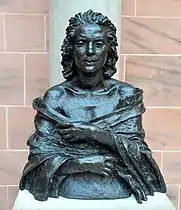 Lilian Shelly, 1920. By Sir Jacob Epstein. Bronze
Lilian Shelly, 1920. By Sir Jacob Epstein. Bronze Persian carpets
Persian carpets Buddha, with right arm raised in benediction. Sandstone. From India, Mathura. Gupta period, 5th–6th century CE
Buddha, with right arm raised in benediction. Sandstone. From India, Mathura. Gupta period, 5th–6th century CE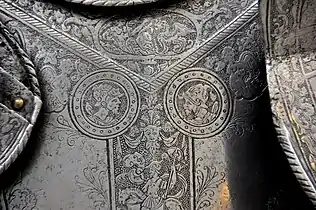 Detail of body armour from Medieval Europe
Detail of body armour from Medieval Europe Close-up image of tomb of a knight of the Espes family. Painted limestone. Spanish, mid-14th century CE
Close-up image of tomb of a knight of the Espes family. Painted limestone. Spanish, mid-14th century CE Virgin and Child. Alabaster, with traces of paint and gilding. From Southern Netherland, c. 1475–1500 CE
Virgin and Child. Alabaster, with traces of paint and gilding. From Southern Netherland, c. 1475–1500 CE Christ on the cross, flanked by the Virgin and St. John the Evangelist and 4 other saints. Retable. Painted limestone. From Burgundy, France, c. 1450–1500 CE
Christ on the cross, flanked by the Virgin and St. John the Evangelist and 4 other saints. Retable. Painted limestone. From Burgundy, France, c. 1450–1500 CE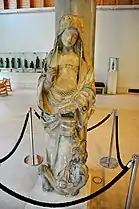 St. Margaret. Limestone. From France, c. 1500 CE
St. Margaret. Limestone. From France, c. 1500 CE Lamentation over the crucified Christ. Painted limewood. From Germany, Augsburg, c. 1510–1520 CE
Lamentation over the crucified Christ. Painted limewood. From Germany, Augsburg, c. 1510–1520 CE Glass dish. Green-tinted moulded glass. From Fustat, Egypt. Fatimid period, 11th century CE
Glass dish. Green-tinted moulded glass. From Fustat, Egypt. Fatimid period, 11th century CE Ram's head. Limestone. From China, Tang Dynasty, 618–907 CE
Ram's head. Limestone. From China, Tang Dynasty, 618–907 CE Elamite archer. Alabaster. From Nineveh, Iraq. Reign of Ashurbanipal II, 668–627 BCE
Elamite archer. Alabaster. From Nineveh, Iraq. Reign of Ashurbanipal II, 668–627 BCE Archer wearing feather headdress. Alabaster. From Nineveh, Iraq. Reign of Ashurbanipal II, 668–627 BCE
Archer wearing feather headdress. Alabaster. From Nineveh, Iraq. Reign of Ashurbanipal II, 668–627 BCE Alabaster bull inlay. From southern Iraq, Early Dynastic Period, c. 2750-2400 BCE
Alabaster bull inlay. From southern Iraq, Early Dynastic Period, c. 2750-2400 BCE Detail of funerary stela of Amenemhat. The name of God Amun was erased by Akhenaten's agents. Limestone, painted. From Egypt, early 18th Dynasty
Detail of funerary stela of Amenemhat. The name of God Amun was erased by Akhenaten's agents. Limestone, painted. From Egypt, early 18th Dynasty One of the halls of the Burrell Collection
One of the halls of the Burrell Collection One of the halls of the Burrell Collection
One of the halls of the Burrell Collection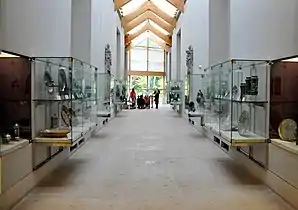 One of the halls of the Burrell Collection
One of the halls of the Burrell Collection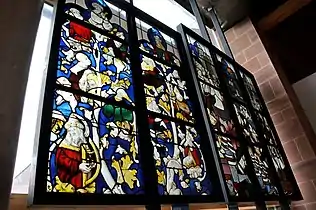 Stained glass. Medieval Europe
Stained glass. Medieval Europe
See also
References
- https://www.bbc.co.uk/news/uk-scotland-glasgow-west-37739424
- https://www.thetimes.co.uk/edition/scotland/further-delay-for-gallery-reopening-80fdwlx6m
- "The Burrell Museum, Burrell Collection, Glasgow Museum". Glasgowarchitecture.co.uk. Retrieved 17 February 2008.
- http://www.culture24.org.uk/sc000074
- "The Burrell Collection". Glasgow Museums. Retrieved 17 February 2008.
- "Burrell Collection – Glasgow Museum Building". Glasgowarchitecture.co.uk. 1 February 2013. Retrieved 22 August 2013.
- http://www.glasgowlife.org.uk/museums/burrell-collection/Pages/default.aspx
- http://www.culture24.org.uk/art/painting-and-drawing/art473179
- "CARP: From Collector To Connoisseur: Sir William Burrell and Chinese Art, 1911–57". Carp.arts.gla.ac.uk. Retrieved 22 August 2013.
- "Discover Islamic Art – Virtual Museum". Discoverislamicart.org. Retrieved 22 August 2013.
- http://www.cannon-macinnes.co.uk/linda-cannon/
- Friar, Stephen, ed. (1987). A New Dictionary of Heraldry. London: Alphabooks/A&C Black. p. 103. ISBN 0 906670 44 6.
- "New Conservation Project Under Way at The Burrell Collection". Vidimus (68). 17 April 2013. Retrieved 22 August 2013.
- http://www.glasgowlife.org.uk/museums/burrell-collection/the-collection/Pages/The-Collection.aspx
External links
| Wikimedia Commons has media related to Burrell Collection. |
- Glasgow Museums (Burrell Collection official website)
- BBC Arts & Culture: Highlights from the Burrell Collection
- BBC Your Paintings: Paintings at The Burrell Collection
- BBC History: The ships that bought an art collection
- House of Commons Motion (11 May 1966) re. Burrell Collection. Hansard
- Blog following the ongoing Boppard Conservation Project
- Morrison, Richard (21 June 2013). "Do donors' wishes still matter?". The Times.
Further reading
- Cannon, Linda (1991). Stained Glass in the Burrell Collection. Chambers. ISBN 9780550225658.
- Carpets and Tapestries from the Burrell Collection. Glasgow Art Gallery and Museum. 1969.
- The Burrell Collection: Gothic Tapestries : A Selection. Burrell Collection.
- Peltenburg (1991). Western Asiatic antiquities: the Burrell Collection. Burrell Collection. ISBN 9780748602247.
- Paintings from the Burrell Collection. Arts Council of Great Britain. 1950.
